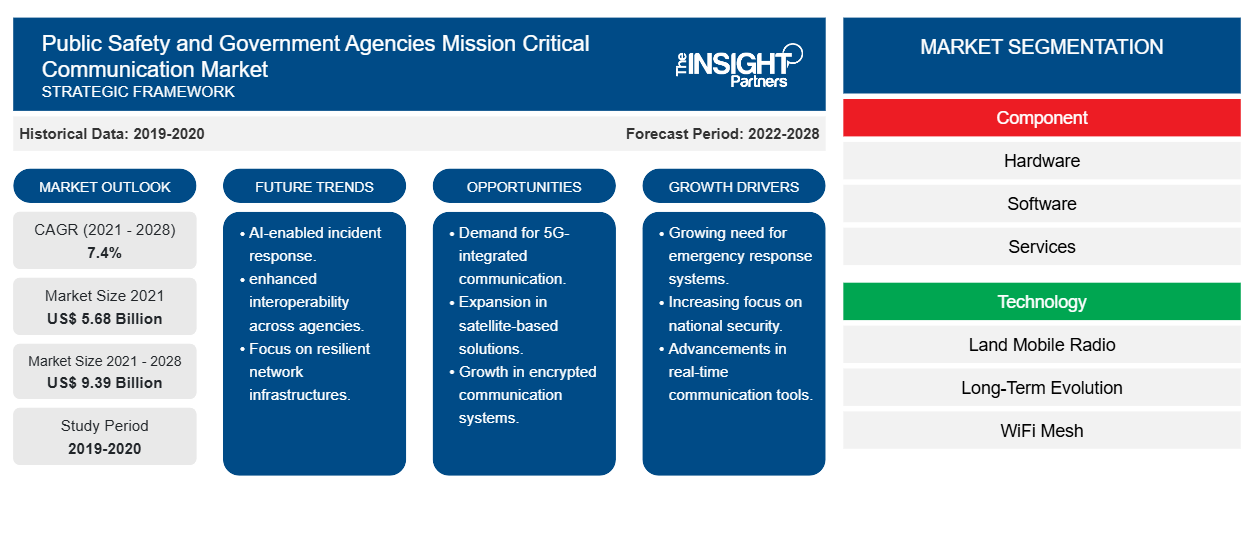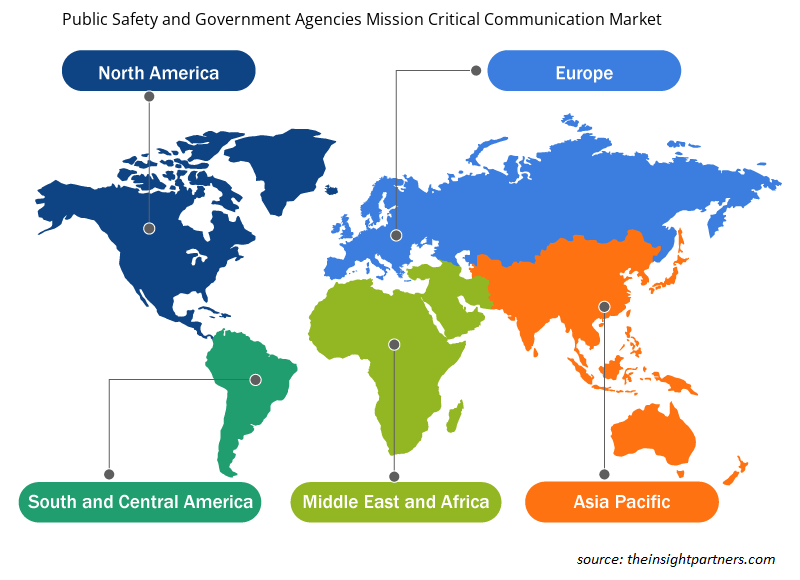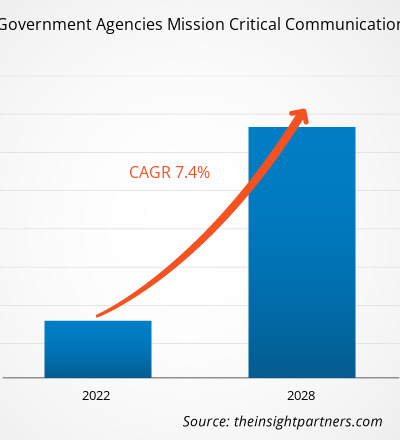Il mercato delle comunicazioni mission critical delle agenzie governative e per la sicurezza pubblica è stato valutato a 5.684,3 milioni di dollari USA nel 2021 e si prevede che raggiungerà i 9.390,0 milioni di dollari USA entro il 2028; si prevede una crescita a un CAGR del 7,4% dal 2021 al 2028.
Una comunicazione mission-critical implica soluzioni che aiutano i metodi di comunicazione agli utenti finali in situazioni in cui i sistemi tradizionali non riescono a soddisfare le loro richieste. Inoltre, il mercato della comunicazione mission-critical delle agenzie governative e della sicurezza pubblica facilita la comunicazione e supporta operazioni che sono piene di pericoli per le persone e le proprietà. Dispositivi di comunicazione cruciali sono utilizzati per istruire le persone sulle situazioni critiche. Nel mercato della comunicazione mission-critical delle agenzie governative e della sicurezza pubblica , gli operatori di rete si concentrano su nuove strategie di progettazione e gestione per l'infrastruttura di comunicazione per rispondere alla rapida evoluzione della rete e del servizio per garantire un funzionamento affidabile della rete.
Impatto della pandemia di COVID-19 sulla sicurezza pubblica e sulle agenzie governative Mercato delle comunicazioni mission critical
L'epidemia di COVID-19 ha avuto un impatto significativo sul mercato delle comunicazioni mission critical per la sicurezza pubblica e le agenzie governative in Nord America, con conseguenti perdite finanziarie sostanziali per le industrie di utilizzo finale, spingendole a posticipare ulteriormente i loro piani di implementazione MCX. L'epidemia ha avuto un impatto anche sulle operazioni presso i siti di produzione hardware del mercato delle comunicazioni mission critical per la sicurezza pubblica e le agenzie governative, richiedendo una breve interruzione. Di conseguenza, diversi importanti fornitori di componenti e fornitori di tecnologia hanno tagliato i costi e la produzione. Poiché la domanda di elettronica è rimasta costante, ha aiutato il mercato a riprendere a crescere.
Personalizza questo report in base alle tue esigenze
Riceverai la personalizzazione gratuita di qualsiasi report, comprese parti di questo report, o analisi a livello nazionale, pacchetto dati Excel, oltre a usufruire di grandi offerte e sconti per start-up e università
Mercato delle comunicazioni critiche per la sicurezza pubblica e le agenzie governative: approfondimenti strategici

-
Scopri le principali tendenze di mercato in questo rapporto.Questo campione GRATUITO includerà analisi di dati che spaziano dalle tendenze di mercato alle stime e alle previsioni.
Approfondimenti di mercato
Domanda crescente da parte di varie agenzie governative che stimola la crescita della sicurezza pubblica e del mercato delle comunicazioni mission critical delle agenzie governative
I cittadini si aspettano un servizio e una comunicazione 24 ore su 24 dalle agenzie governative. Desiderano un facile accesso a informazioni corrette e aggiornate e una connessione fluida con i funzionari governativi appropriati. Vogliono anche che i servizi siano forniti rapidamente, efficacemente e in modo trasparente e che i problemi siano risolti rapidamente, efficacemente e apertamente. Molte agenzie governative si affidano ancora a infrastrutture di comunicazione obsolete, come sistemi PBX in leasing o sistemi di tipo Centrex. Inoltre, nel mercato della comunicazione critica per la sicurezza pubblica e le agenzie governative, i governi stanno sviluppando e mantenendo eccellenti sistemi di comunicazione per essere attori rispettabili nelle sfere pubbliche. I fattori di cui sopra consentono loro di valutare le esigenze e le preferenze dei residenti e promuovere un'arena pubblica deliberativa per il coinvolgimento di più parti interessate, un dibattito politico informato e l'efficacia dello sviluppo di emergenza. Tutti questi problemi spingono la domanda di mercato della comunicazione critica per la sicurezza pubblica e le agenzie governative.
Approfondimenti di mercato basati sui componenti
I componenti hardware del mercato delle comunicazioni mission critical per la sicurezza pubblica e le agenzie governative includono centri di comando e controllo, router e gateway e sistemi di gestione della distribuzione. L'implementazione dei componenti hardware varia a seconda della natura dell'agenzia di sicurezza pubblica. Il crescente numero di crimini segnalati in tutto il mondo spinge la domanda di mercato delle comunicazioni mission critical per la sicurezza pubblica e le agenzie governative.
Approfondimenti di mercato basati sulla tecnologia
La radio mobile terrestre (LMR), nota anche come radio bidirezionale, è una delle tecnologie di comunicazione più ampiamente utilizzate nel mercato delle comunicazioni mission critical per la sicurezza pubblica e le agenzie governative. La tecnologia è costantemente sottoposta a test e perfezionamento ed è considerata un punto di riferimento per il successo delle comunicazioni critiche, in particolare nella sicurezza pubblica.
Nel mercato della comunicazione mission critical per la sicurezza pubblica e le agenzie governative, lo sviluppo del prodotto è la strategia comunemente adottata dalle aziende per espandere il loro portafoglio prodotti, il che le aiuta ad ampliare la loro base clienti e a mantenere il loro marchio. Ecco alcuni dei recenti sviluppi chiave nel mercato:
- Nel 2021, il governo della Repubblica di Indonesia ha distribuito 500 dispositivi Push-to-Talk (PTT) Iridium, acquistati da Iridium Communications Inc., per potenziare le operazioni di comunicazione in tutto il paese. Il governo indonesiano ora dispone di una soluzione affidabile di comunicazioni satellitari in tempo reale "grab-and-go", adatta per comunicazioni in movimento nei numerosi paesaggi insulari del paese.
- Nel 2021, Inmarsat ha confermato che BSNL, il suo partner strategico in India, si è assicurato le licenze necessarie per fornire i servizi di banda larga mobile Global Xpress (GX) di livello mondiale di Inmarsat. GX sarà fornito ai clienti indiani nei settori governativo, aeronautico e marittimo, in base alla licenza Inflight and Maritime Connectivity (IFMC) di BSNL del Dipartimento delle telecomunicazioni.
Sicurezza pubblica e agenzie governative Mercato delle comunicazioni critiche per la missione Approfondimenti regionali
Le tendenze regionali e i fattori che influenzano il mercato delle comunicazioni mission-critical per la sicurezza pubblica e le agenzie governative durante il periodo di previsione sono stati ampiamente spiegati dagli analisti di Insight Partners. Questa sezione discute anche i segmenti e la geografia del mercato delle comunicazioni mission-critical per la sicurezza pubblica e le agenzie governative in Nord America, Europa, Asia Pacifico, Medio Oriente e Africa e America meridionale e centrale.

- Ottieni i dati regionali specifici per il mercato delle comunicazioni critiche per la sicurezza pubblica e le agenzie governative
Ambito del rapporto di mercato sulla comunicazione critica per la sicurezza pubblica e le agenzie governative
| Attributo del report | Dettagli |
|---|---|
| Dimensioni del mercato nel 2021 | 5,68 miliardi di dollari USA |
| Dimensioni del mercato entro il 2028 | 9,39 miliardi di dollari USA |
| CAGR globale (2021 - 2028) | 7,4% |
| Dati storici | 2019-2020 |
| Periodo di previsione | 2022-2028 |
| Segmenti coperti |
Per componente
|
| Regioni e Paesi coperti |
America del Nord
|
| Leader di mercato e profili aziendali chiave |
|
Sicurezza pubblica e agenzie governative Mission Critical Communication Market Players Densità: comprendere il suo impatto sulle dinamiche aziendali
Il mercato delle comunicazioni mission critical per la sicurezza pubblica e le agenzie governative sta crescendo rapidamente, spinto dalla crescente domanda degli utenti finali dovuta a fattori quali l'evoluzione delle preferenze dei consumatori, i progressi tecnologici e una maggiore consapevolezza dei vantaggi del prodotto. Con l'aumento della domanda, le aziende stanno ampliando le loro offerte, innovando per soddisfare le esigenze dei consumatori e capitalizzando sulle tendenze emergenti, il che alimenta ulteriormente la crescita del mercato.
La densità degli operatori di mercato si riferisce alla distribuzione di aziende o società che operano in un particolare mercato o settore. Indica quanti concorrenti (operatori di mercato) sono presenti in un dato spazio di mercato in relazione alle sue dimensioni o al valore di mercato totale.
Le principali aziende che operano nel mercato delle comunicazioni mission critical per la sicurezza pubblica e le agenzie governative sono:
- Società per azioni Ascom Holding AG (Ascom)
- Stella globale
- Inmarsat Global Limited
- Società di comunicazione Iridium Inc.
- società nbn co ltd.
Disclaimer : le aziende elencate sopra non sono classificate secondo un ordine particolare.

- Ottieni una panoramica dei principali attori del mercato delle comunicazioni critiche per la sicurezza pubblica e le agenzie governative
Segmentazione del mercato delle comunicazioni mission critical per la sicurezza pubblica e le agenzie governative:
Per componente
- Hardware
- Software
Per tecnologia
- Evoluzione a lungo termine (LTE)
- Radiomobile terrestre (LMR)
- Maglia WiFi
Profili aziendali
- Società per azioni Ascom Holding AG (Ascom)
- Stella globale
- Inmarsat Global Limited
- Società di comunicazione Iridium Inc.
- società nbn co ltd.
- SES SA
- Telesat
- Società di telecomunicazioni Thuraya
- Società per azioni AT&T Inc.
- SPAZIOX
- Analisi storica (2 anni), anno base, previsione (7 anni) con CAGR
- Analisi PEST e SWOT
- Valore/volume delle dimensioni del mercato - Globale, Regionale, Nazionale
- Industria e panorama competitivo
- Set di dati Excel
Report recenti
Testimonianze
Motivo dell'acquisto
- Processo decisionale informato
- Comprensione delle dinamiche di mercato
- Analisi competitiva
- Analisi dei clienti
- Previsioni di mercato
- Mitigazione del rischio
- Pianificazione strategica
- Giustificazione degli investimenti
- Identificazione dei mercati emergenti
- Miglioramento delle strategie di marketing
- Aumento dell'efficienza operativa
- Allineamento alle tendenze normative






















 Ottieni un campione gratuito per - Mercato delle comunicazioni critiche per la sicurezza pubblica e le agenzie governative
Ottieni un campione gratuito per - Mercato delle comunicazioni critiche per la sicurezza pubblica e le agenzie governative